
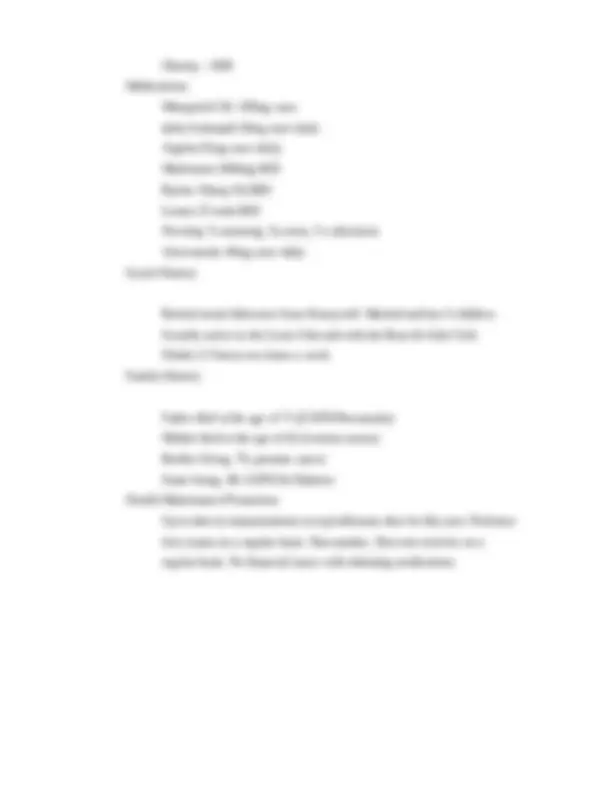
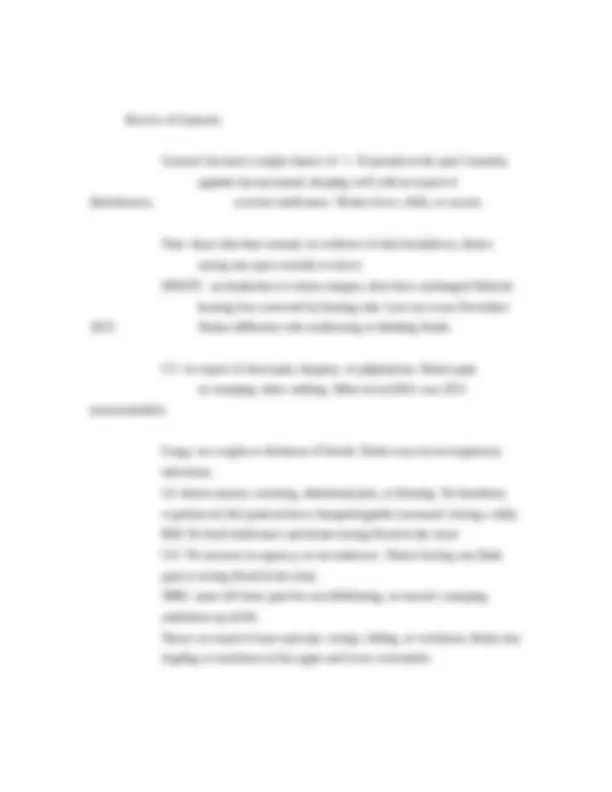
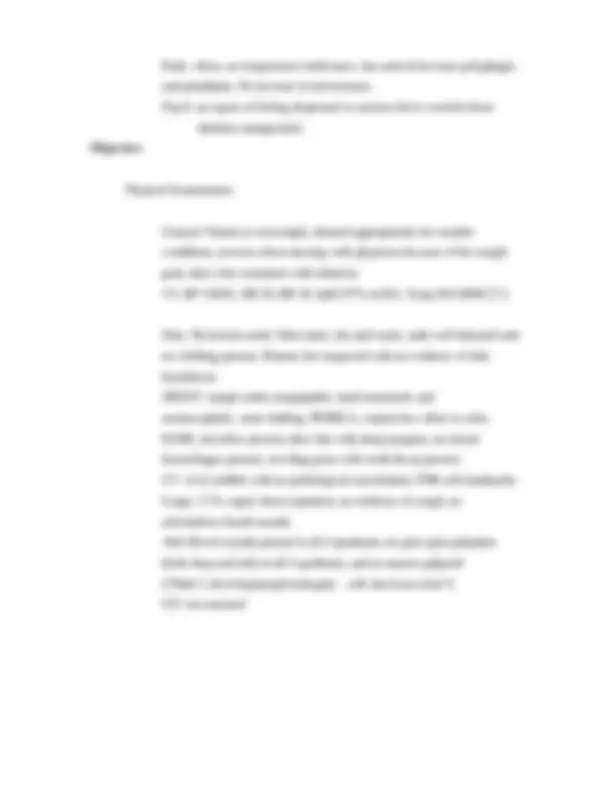
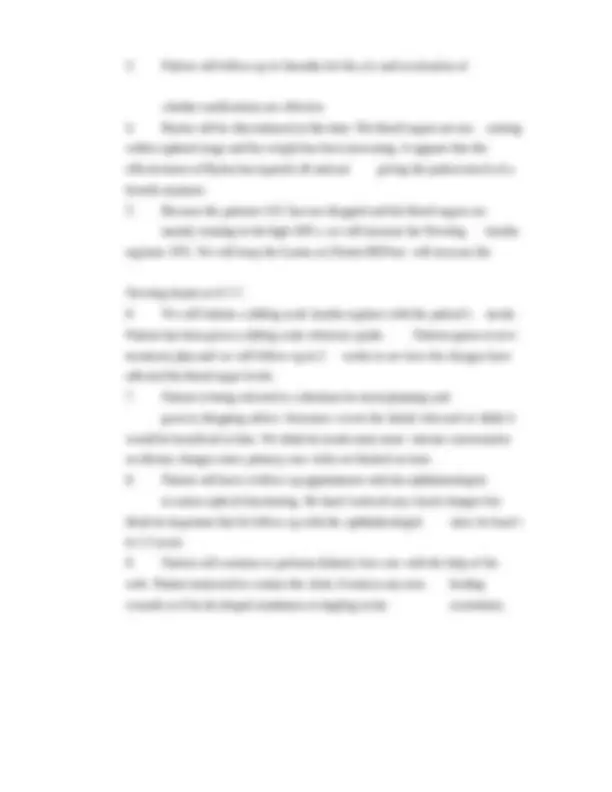
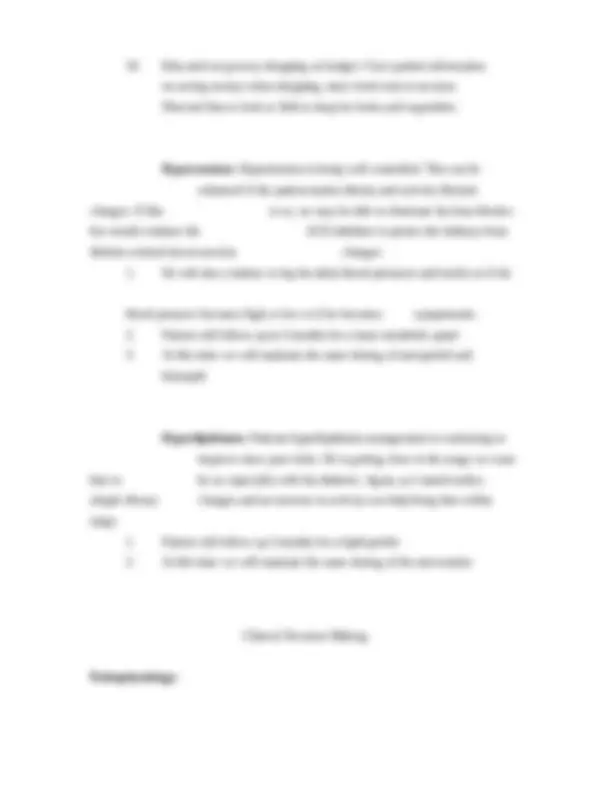
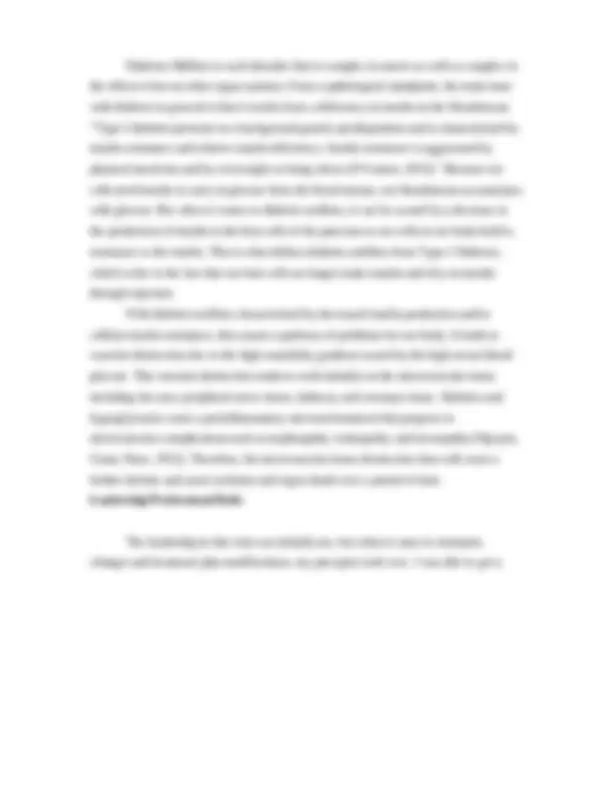
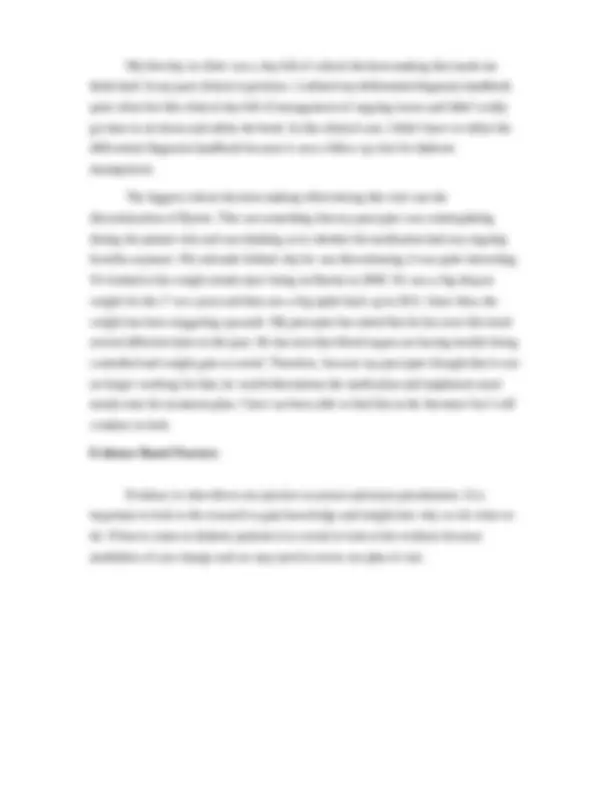
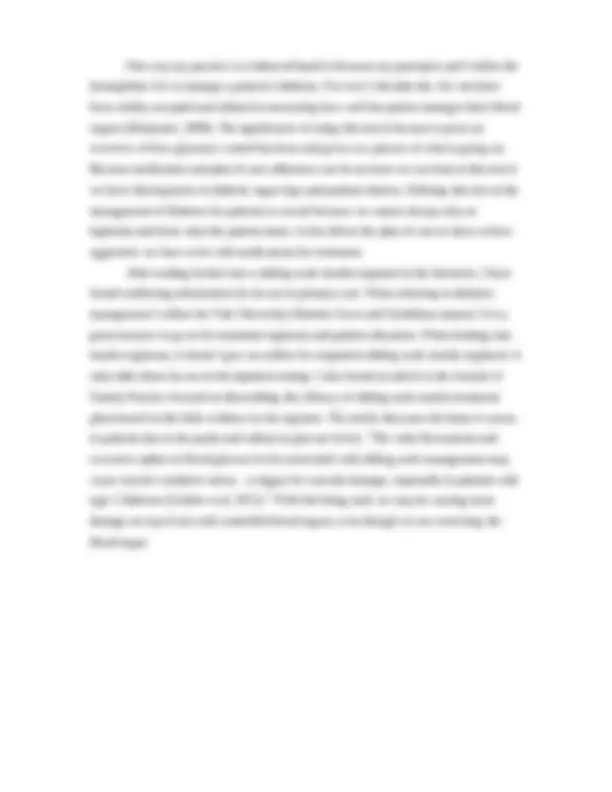
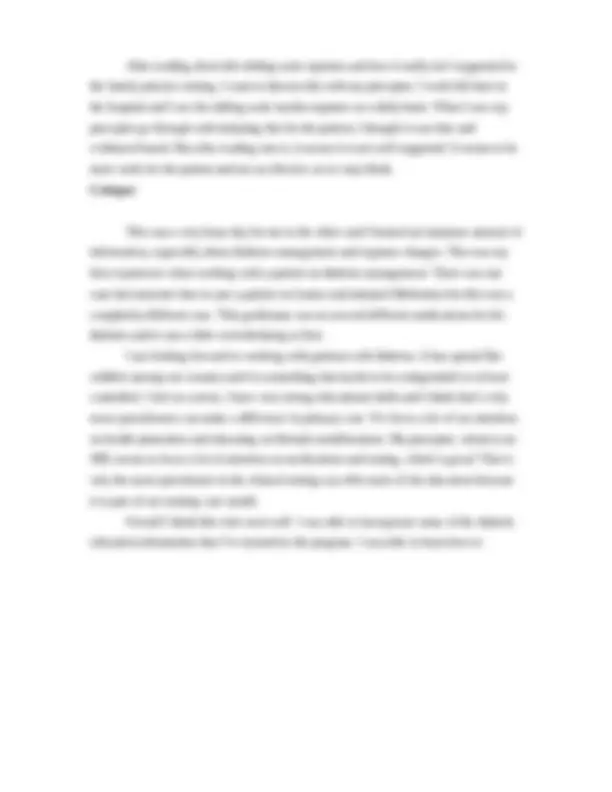
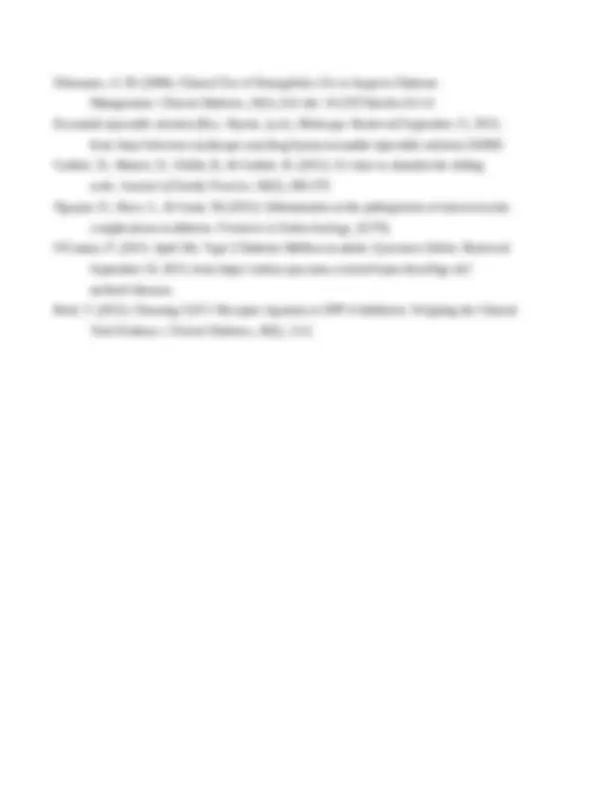


Study with the several resources on Docsity

Earn points by helping other students or get them with a premium plan


Prepare for your exams
Study with the several resources on Docsity

Earn points to download
Earn points by helping other students or get them with a premium plan
Community
Ask the community for help and clear up your study doubts
Discover the best universities in your country according to Docsity users
Free resources
Download our free guides on studying techniques, anxiety management strategies, and thesis advice from Docsity tutors
NURSING: -DIABETES WELL EXPLAINED RATED A+ DOWNLOAD TO SCORE A WITH REFERENCES/2023.Qualified
Typology: Essays (university)
1 / 18

This page cannot be seen from the preview
Don't miss anything!











Diabetes Mellitus Management SOAP # Michael Thorn
Objective: History of Present Illness: Patient is a 66-year-old Caucasian male here today for his 3-month follow up for his diabetes mellitus management. He was diagnosed back in 2008 and has had issues in maintaining his blood sugars and changing his lifestyle habits (diet and exercise). He checks his blood sugars on a consistent basis and logs them appropriately. His A1C in May of this year was 7.9. He currently is taking Metformin, Byetta, Lantus, and Novolog for his DM II management. Patient is frustrated at this time because he has to face the physician and go over his gain in weight and the need to change medication management. He states that he has been trying to watch his diet but has not been getting exercise in his daily life. Patients log of recent blood sugars (10 days) Blood Sugar Log Averages Morning: 232 190 201 145 133 186 199 155 175 166 Noon: 175 169 210 132 178 240 112 90 142 178 Bedtime: 110 131 180 210 160 224 155 121 190 285 Past Medical & Surgical History: Diabetes Mellitus – 2008 Hyperlipidemia – 1998 Hypertension – 1993 Left Knee Arthroplasty – 2010
Review of Systems: General: has had a weight chance of +/- 10 pounds in the past 3 months, appetite has increased, sleeping well with no report of disturbances; exercise intolerance. Denies fever, chills, or sweats. Skin: dryer skin than normal; no evidence of skin breakdown, denies seeing any open wounds or ulcers HEENT: no headaches or vision changes, does have unchanged bilateral hearing loss corrected by hearing aids. Last eye exam November
Endo: obese, no temperature intolerance, has noticed increase polyphagia and polydipsia. No increase in nervousness. Psych: no report of feeling depressed or anxious but is worried about diabetes management. Objective: Physical Examination: General: Patient is overweight, dressed appropriately for weather conditions, nervous about meeting with physician because of his weight gain; skin color consistent with ethnicity. VS: BP 136/81, HR 59, RR 18, Sp02 97% on RA, Temp 36.6 BMI 27. Skin: No lesions noted. Skin intact, dry and warm, nails well trimmed and no clubbing present. Bottom feet inspected with no evidence of skin breakdown. HEENT: lymph nodes nonpalpable; head atraumatic and normocephalic, some balding, PERRLA, conjunctiva white in color, EOMI, red reflex present, discs flat with sharp margins, no retinal hemorrhages present, receding gums with tooth decay present. CV: s1/s2 audible with no pathological auscultation; PMI with landmarks Lungs: CTA, equal chest expansion, no evidence of cough; no adventitious breath sounds. Abd: Bowel sounds present in all 4 quadrants, no pain upon palpation (both deep and soft) in all 4 quadrants, and no masses palpated (Didn’t check hepatosplenomegaly – will check next time) GU: not assessed
modifications. Patient has been adhering to medication dosing but has not been following dietary and lifestyle changes.
Diabetes Mellitus is such disorder that is complex in nature as well as complex in the effects it has on other organ systems. From a pathological standpoint, the main issue with diabetes in general is that it results from a deficiency in insulin in the bloodstream. “Type 2 diabetes presents on a background genetic predisposition and is characterized by insulin resistance and relative insulin deficiency. Insulin resistance is aggravated by physical inactivity and by overweight or being obese (O’Connor, 2013).” Because our cells need insulin to carry in glucose from the blood stream, our bloodstream accumulates with glucose. But when it comes to diabetes mellitus, it can be caused by a decrease in the production of insulin in the beta cells of the pancreas or our cells in our body build a resistance to the insulin. This is what defines diabetes mellitus from Type-1 Diabetes, which is due to the fact that our beta cells no longer make insulin and rely on insulin through injection. With diabetes mellitus characterized by decreased insulin production and/or cellular insulin resistance, this causes a pathway of problems for our body. It leads to vascular destruction due to the high osmolality gradient caused by the high serum blood glucose. This vascular destruction tends to work initially on the microvascular tissue including the eyes, peripheral nerve tissue, kidneys, and coronary tissue. Diabetes and hyperglycemia create a proinflammatory microenvironment that progress to microvascular complications such as nephropathy, retinopathy, and neuropathy (Nguyen, Grant, Shaw, 2012). Therefore, the microvascular tissue destruction then will cause a further decline and cause ischemia and organ death over a period of time. Leadership/Professional Role: The leadership in this visit was initially me, but when it came to treatment changes and treatment plan modifications, my preceptor took over. I was able to get a
good history on the patient and identify issues in the follow up. I was able to lead the education for the patient and provide health promotion from a nursing perspective. When it came to the treatment plan, my preceptor took over and helped the patient and I understand what was going to change and why. Barriers to Care: There was one perceived barrier in this visit and it was dietary intake associated with finances. He will be going to go see a nutritionist to talk about modifying his meal plans. Patient has had a hard time trying to eat better and it is due to “everything good for you costs too much.” Explaining to him that, even though the costs of the food are higher than junk food, the costs of increasing the medications and the increase in the progression of his illnesses cost more in the long run. I also advised him to locate Aldi’s grocery stores. He could be saving a lot of money on groceries and he would be able to buy groceries that were good and nutritious for him. He liked the idea and I helped him locate a couple stores in his residential area. Hopefully this education will help alleviate barriers in the future. Pharmacology Information: Incretin is a hormone, which is produced in the gastrointestinal tract and responds to food when it enters. This hormone causes the pancreas to quickly release insulin to help initiate the push of glucose into the cells because more glucose will be entering the bloodstream. GLP-1, also known as glucagon like peptide-1, is derived from incretin and plays a crucial role in helping people with Diabetes Mellitus because of its role in slowing down gastric contents, increasing insulin secretion, and by increasing satiety in the brain (Cooppan, n.d.).
My first day in clinic was a day full of critical decision-making that made me think hard. In my past clinical experience, I utilized my differential diagnosis handbook quite often but this clinical day full of management of ongoing issues and didn’t really get time to sit down and utilize the book. In this clinical case, I didn’t have to utilize the differential diagnosis handbook because it was a follow up visit for diabetes management. The biggest critical decision making effort during this visit was the discontinuation of Byetta. This was something that my preceptor was contemplating during the patient visit and was thinking as to whether the medication had any ongoing benefits anymore. His rationale behind why he was discontinuing it was quite interesting. We looked at his weight trends since being on Byetta in 2008. We saw a big drop in weight for the 1st^ two years and then saw a big spike back up in 2011. Since then, the weight has been staggering upwards. My preceptor has stated that he has seen this trend several different times in the past. He has seen that blood sugars are having trouble being controlled and weight gain occurred. Therefore, because my preceptor thought that it was no longer working for him, he would discontinue the medication and implement more insulin into the treatment plan. I have not been able to find this in the literature but I will continue to look. Evidence Based Practice: Evidence is what drives our practice as nurses and nurse practitioners. It is important to look to the research to gain knowledge and insight into why we do what we do. When it comes to diabetic patients it is crucial to look at the evidence because modalities of care change and we may need to revise our plan of care.
One-way my practice is evidenced based is because my preceptor and I utilize the hemoglobin A1c to manage a patient’s diabetes. For over 2 decades the A1c test have been widely accepted and utilized in measuring how well the patient manages their blood sugars (Delamater, 2006). The significance of using this test is because it gives an overview of how glycemic control has been and gives us a picture of what is going on. Because medication and plan of care adherence can be an issue we can look at this test if we have discrepancies in diabetic sugar logs and patients history. Utilizing this test in the management of diabetes for patients is crucial because we cannot always rely on logbooks and from what the patient states. It also drives the plan of care to show us how aggressive we have to be with medications for treatment. After reading further into a sliding scale insulin regiment in the literature, I have found conflicting information for its use in primary care. When referring to diabetes management I utilize the Yale University Diabetes Facts and Guidelines manual. It is a great resource to go to for treatment regimens and patient education. When looking into insulin regimens, it doesn’t give an outline for outpatient sliding scale insulin regiment. It only talks about its use in the inpatient setting. I also found an article in the Journal of Family Practice focused on discrediting the efficacy of sliding scale insulin treatment plans based on the little evidence in the regimen. The article discusses the harm it causes to patients due to the peaks and valleys in glucose levels. “The wide fluctuations and excessive spikes in blood glucose levels associated with sliding scale management may cause reactive oxidative stress – a trigger for vascular damage, especially in patients with type 2 diabetes (Guthrie et al, 2011).” With this being said, we may be causing more damage on top of not well-controlled blood sugars, even though we are correcting the blood sugar.
increase insulin dosages and what to watch for in blood glucose patient logs. I have a lot to learn but that is why I am here! References Byetta - Patient Education. (2012, March 8). Epocrates Online. Retrieved September 10, 2013,
from https://online.epocrates.com/noFrame/showPage.do?method=drugs Cooppan, R. (n.d.). Type 2 Diabetes: The Pathophysiologic Basis of Treatment Design. Medscape. Retrieved September 16, 2013, from http://www.medscape.org/viewarticle/